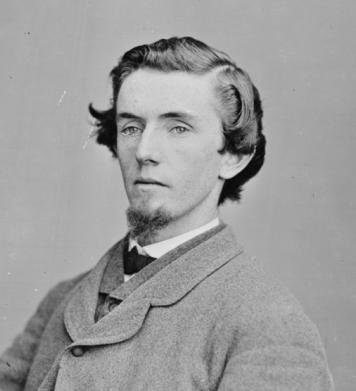Spinning the Web: John Wilkes Booth and the Lincoln Assassination Conspirators
 |
| David Herold |
|
During the summer of 1864, John Wilkes Booth convinced two old friends, Samuel Arnold and Michael O'Laughlen, to join him in a plot to kidnap President Abraham Lincoln and hold him until the United States released thousands of captured Confederate soldiers. Within months, Booth was actively recruiting other conspirators.
 |
| "Ned" Spangler |
He enlisted a young drug store clerk named David Herold. A
native Marylander living in Washington with his widowed mother and a
household full of sisters, Herold knew his way around Washington’s
back alleys and Maryland’s back roads. He also knew how to handle
a gun. Booth also renewed his acquaintance with Edmund (or Edman) "Ned" Spangler, who had
once worked as a carpenter on the farm where Booth grew up. Spangler was a handyman at Ford’s Theatre. Generous doses of the actor’s
charm (plus generous doses of liquor) convinced him to run errands and
do odd jobs for Booth. While Spangler is often identified as a member
of the conspiracy, it's quite likely he didn't really know what was going
on and was little more than a “gofer” for his famous patron.
 |
| Dr. Samuel Mudd |
By autumn 1864, after another trip to Montreal (and perhaps more contacts with the Confederate underground there), Booth took up more or
less permanent residence in Washington. He used his room at the
elegant National Hotel as a base for his expanding operations. He went for long rides in the Maryland countryside, sometimes claiming he was looking to buy horses or a piece of rural property. In truth he was
scouting potential escape routes. He was also asking questions,
learning who in the area supported the Confederate Cause and who was
actively involved in clandestine Confederate operations. On one such mission
in November, he visited a Catholic church in Bryantown and was
introduced to Dr. Samuel Mudd, a Southern sympathizer who also farmed,
traded horses, bought and sold land. Booth used Mudd as a sounding board
about people living in the area.
 |
| John Surratt Jr. |
Booth wanted to meet one of them in particular. Along the way,
someone somewhere whispered the name John Surratt in the actor’s
ear. Another native Marylander, Surratt ostensibly held a job at a
Washington express company. But after hours he quietly carried coded
messages, led Confederate agents and directed smuggled medical
supplies along the treacherous route from Canada to the Confederacy.
Surratt was in reality what Booth fancied himself to be – a bona
fide agent of the Confederate secret service. He was just the type of
man Booth needed to pull all the loose ends of his plot together.
 |
| George Atzerodt |
Surratt brought the last two conspirators into the fold. George
Atzerodt was a short, dumpy, ne’er-do-well most often described as
“seedy.” He lived in the Potomac River town of Port Tobacco
(which also was his nickname), where he worked on carriages during the
day. At night he paddled a small boat across the Potomac, helping smugglers evade Union patrols.
 |
| Lewis Powell |
|
Finally, there was one of the most enigmatic and fascinating
members of Booth’s band – Lewis Thornton Powell. A young former
Confederate soldier with a strong chin, broad forehead, riveting
stare and immense physical strength, he enlisted in a
Florida infantry regiment early in the war. He was wounded in 1862 and after his recovery, he returned to the Confederate Army until he was wounded again -- and captured by Union forces -- at Gettysburg. He later
escaped confinement and a murky 18-month period followed, during which he served under Col. John Singleton Mosby, the “Gray Ghost of the
Confederacy.” In January 1865 Powell arrived in Alexandria, Virginia
and signed a loyalty oath to the Union under the alias Lewis Paine,
the name history would remember him by for the next 140 years.
 |
| Louis J. Weichmann |
Not everyone who was approached joined the conspiracy. Actors Samuel
Chester and John Matthews rebuffed Booth’s approaches and Dr. Mudd
declined to take an active role. Meantime, Surratt did his best to keep one
man
out of the plot – his roommate and former seminary classmate
Louis J. Weichmann. While he was a low-level employee in an obscure
section of the War Department, Weichmann was also nosy and
self-important. He sensed Surratt was up to something but never
figured out what it was. (Later, after his own arrest, Weichmann would tell investigators he thought all secret comings and goings had something to do with Booth’s oil speculations.)
John Surratt was also responsible for another element of the conspiracy
– a central location where the plotters could meet from time to
time. He convinced his widowed mother Mary to open her boardinghouse
at 541 H Street in Washington to his co-conspirators. There,
frequent, unexplained comings and goings hardly seemed unusual. The Surratt boardinghouse became the center of the conspirators' web.
 |
| Surratt Boardinghouse in Washington |








No comments:
Post a Comment